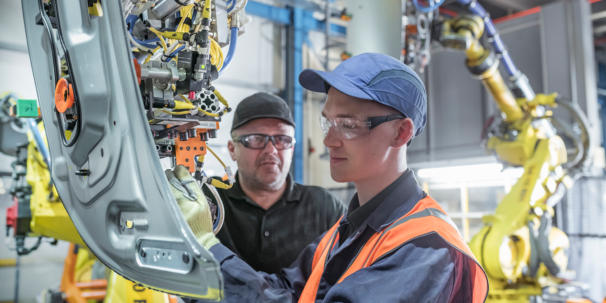The future of robotics: How will robots change the world?
In this introduction to robotics, we take a look at what robots are, how they’re currently used, and how they might shape the world in the future.

When we think of robots, we might imagine sci-fi inspired, human-like automatons. While these types of machines are still mostly still fictional, there are many other types of robots operating in the world today. But what are robots? And how will they change the world?
Here, we explore the history and types of robots, some pros and cons of using them, and how they might shape the future. We’ll also outline some of the skills you’ll need to get started with robotics and highlight some courses to help you build your skills.
What are robots?
Let’s start with some definitions. Most of us are familiar with the concept of robots but may struggle to actually define them as a separate entity from other types of machines.
As you’ll see, robots are different from other machines because of how they interact with the world. They can make changes to their surroundings based on their actions and respond to the world around them.
A more detailed definition explains that:
‘Robotic systems can be defined as interconnected, interactive, cognitive and physical tools that are able to perceive the environment using sensors, reason about events, make plans using algorithms implemented in computer programs, and perform actions enabled by actuators.’
Robots are tools that can autonomously sense, reason, plan, and action. As well as performing tasks independently, they can also extend human capabilities, and mimic human actions. It’s also worth noting that the word robot is derived from the Czech word robota, meaning forced labour.




What is robotics?
Robotics is the discipline of creating robots. It’s a multidisciplinary field where computer science, engineering, and technology all meet. Those working in robotics focus on the design, construction, operation, and use of robots in a host of different settings.
Traditionally, the field of robotics centres on creating robots to perform simple or repetitive tasks at scale or to function in hazardous conditions where humans would otherwise be unable to work.
However, recent developments in machine learning and artificial intelligence mean that we may see an increase in human-to-robot interactions in the future.
The robotics industry is expected to grow significantly over the coming years. Estimates suggest that the sector could be worth as much as $260 billion by 2030. Much of this growth will come from professional services robots that perform useful tasks for humans, such as cleaning, delivering, and transporting.
Types of robots
Although the concept of robots has existed for many years, it’s only been in the last few decades that they’ve grown in complexity and use. Nowadays, there are many practical applications for robots across a wide range of fields.
Some of these types of robots include:
- Industrial. Perhaps the most common use of robots is for simple and repetitive industrial tasks. Examples include assembly line processes, picking and packing, welding, and similar functions. They offer reliability, accuracy, and speed.
- Military. More recent developments mean that military forces worldwide use robots in areas such as UAVs (Unmanned Aerial Vehicle), UGVs (Unmanned Ground Vehicle), triage and surveillance.
- Service. One of the main growth areas in robotics is in the personal service industry. Uses include manual tasks such as dispensing food and cleaning.
- Exploration. We often use robots to reach hostile or otherwise inaccessible areas. A good example of exploratory robots is in space exploration, for example, the Curiosity Rover on Mars.
- Hazardous environments. Again, certain environments can be dangerous for humans to enter, such as disaster areas, places with high radiation, and extreme environments.
- Medical. In the world of healthcare, medtech robots are being used in all kinds of ways. Whether it’s managing laboratory specimens or assisting with surgery, rehabilitation, or physiotherapy.
- Entertainment. Increasingly, people are buying robots for enjoyment. There are several popular toy robots, and there are even robot restaurants and giant robot statues.




Advantages and disadvantages of robots
The field of robotics offers solutions to many different problems. As we’ll see, the future of robots could change the world we live in. However, that doesn’t mean there aren’t downsides to the technology.
There are various pros and cons of using robots in our modern world:
Advantages of robots
- They can offer increased productivity, efficiency, quality and consistency in certain settings.
- Unlike humans, robots don’t get bored.
- Until they wear out, they can repeat the same process continuously.
- They can be very accurate, even to fractions of an inch, making them particularly useful in the manufacturing of microelectronics.
- Robots can work in environments that are unsafe for humans, such as working with dangerous chemicals or in areas of high radiation.
- They don’t have physical or environmental needs in the same way humans do.
- Some robots have sensors and actuators which are more capable than humans.
Disadvantages of robots
- In some industries, robots are replacing human jobs, which can create economic problems.
- On the whole, robots can only do what they are told to do, meaning they can’t improvise (although AI and machine learning is changing this).
- Current robotics technology means that most machines are less dexterous than humans and can’t compete with a human’s ability to understand what they can see. Although experts are working on developing robots that can better sense the world.
- Robots with practical applications are generally expensive in terms of the initial cost, maintenance, the need for extra components and the need to be programmed to do the task.
The future of robotics: Will robots take over the world?
Robots are already all around us, whether it’s the automated machines that assemble our vehicles or the virtual assistants that use conversational interfaces to help us around the house. Yet as we’ve seen, they’re not currently suitable for all areas of life. But will that change in the future?
Despite fears of an AI takeover, where machines replace humans as the dominant intelligence on the planet, such a scenario seems unlikely. However, business network PwC predicts that up to 30% of jobs could be automated by robots by the mid-2030s.
Other reports suggest that the stock of robots worldwide could reach 20 million by 2030, with automated workers taking up to 51 million jobs in the next 10 years. So, while they may not take over the world, we can expect to see more robots in our daily lives.
How robots will change the world
According to a report from McKinsey, automation and machines will see a shift in the way we work. They predict that across Europe, workers may need different skills to find work. Their model shows that activities that require mainly physical and manual skills will decline by 18% by 2030, while those requiring basic cognitive skills will decline by 28%.
Workers will need technological skills, and there will be an even greater need for those with expertise in STEM. Similarly, many roles will require socioemotional skills, particularly in roles where robots aren’t good substitutes, such as caregiving and teaching.
We may also see robots as a more integral part of our daily routine. In our homes, many simple tasks such as cooking and cleaning may be totally automated. Similarly, with robots that can use computer vision and natural language processing, we may see machines that can interact with the world more, such as self-driving cars and digital assistants.
Robotics may also shape the future of medicine. Surgical robots can perform extremely precise operations, and with advances in AI, could eventually carry out surgeries independently.
The ability for machines and robots to learn could give them an even more diverse range of applications. Future robots that can adapt to their surroundings, master new processes, and alter their behaviour would be suited to more complex and dynamic tasks.
Ultimately, robots have the potential to enhance our lives. As well as shouldering the burden of physically demanding or repetitive tasks, they may be able to improve healthcare, make transport more efficient, and give us more freedom to pursue creative endeavours.




How to get started with robotics
If you’re an aspiring roboticist, there are several ways you can get started in the industry. You’ll need to work on some key skills, such as mathematics, science, programming, and problem-solving, but for a practical understanding of robotics, here are a few courses to get you started.
Online robotics courses
- Begin Robotics by University of Reading
- MedTech: AI and Medical Robots by University of Leeds
- Building a Future with Robots by The University of Sheffield
- Deep Learning and Python Programming for AI Microsoft Azure by Cloud Swyft and Microsoft
Final thoughts
Although humanoid robots still remain mostly in the realm of science fiction, robotic machines are all around us. These feats of engineering already help us with many areas of life, and could transform the future for us.
Despite a variety of advantages and disadvantages, one thing’s for sure; those with skills in robotics will be highly sought after in the future. Whether creating, programming or maintaining robots, there will likely always be work in the field of robotics.




